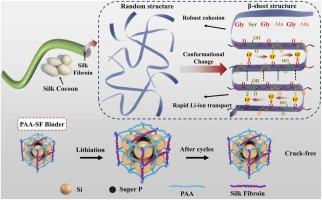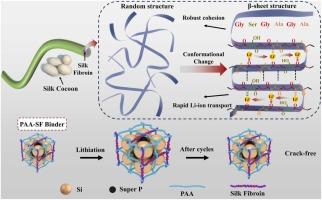丝素蛋白诱导的坚固硅阳极构象变化
IF 17.1
1区 材料科学
Q1 CHEMISTRY, PHYSICAL
引用次数: 0
摘要
传统的粘结剂通常涉及机械联锁力和分子相互作用键合,不能彻底解决硅阳极在循环过程中的大量体积膨胀和随后的快速容量退化问题,限制了高能量密度硅基阳极的大规模商业应用。在此,我们提出了一种新的结合机制,即丝素蛋白(SF)诱导的构象变化来解决这些问题。在聚丙烯酸(PAA)的作用下,SF从无定形相转变为富β-片层结构,构建了层次化有序的PAA-SF结构,通过形成密集排列的结构,提供了优异的机械强度。此外,PAA-SF粘合剂独特的β-富片结构可以通过与锂离子的配位键促进锂离子的扩散。因此,PAA-SF粘结剂有效地缓解了体积膨胀带来的应力,提高了速率能力,并构建了稳定的SEI层,从而延长了硅阳极的循环稳定性。含有这种粘合剂的电池在4.2 a g-1下循环1100次后可以保持600 mAh g-1的高可逆容量。基于构象变化的结合机制的概念为硅和其他硅碳阳极的商业化开辟了一条有希望的途径。本文章由计算机程序翻译,如有差异,请以英文原文为准。


Silk Fibroin-Induced Conformational Change for Robust Silicon Anodes
Conventional binders, commonly involving mechanical interlocking force and molecular interaction bonding, could not thoroughly address substantial volumetric expansion and subsequent rapid capacity degradation of silicon anodes during cycling, limiting large-scale commercial application of high-energy-density of Si-based anodes. Herein, we propose a new binding mechanism, i.e., conformational change induced by silk fibroin (SF) to address these issues. Triggered by polyacrylic acid (PAA), SF undergoes a conformational change from an amorphous phase to β-sheet-rich structure and constructs a hierarchically ordered framework PAA-SF, which provides excellent mechanical strength through the formation of densely packed structures. Additionally, the unique β-sheet-rich structure of the PAA-SF binder could facilitate lithium-ion diffusion via coordination bonds with lithium ions. Consequently, the PAA-SF binder effectively mitigates stress from the volume expansion, enhances the rate capability, and constructs a stable SEI layer, thereby extending the cycling stability of silicon anodes. The cells with this binder can sustain a high reversible capacity of 600 mAh g-1 after 1100 cycles at 4.2 A g-1. The concept of a conformational change-based binding mechanism opens a promising avenue for the commercialization of silicon and other silicon-carbon anodes.
求助全文
通过发布文献求助,成功后即可免费获取论文全文。
去求助
来源期刊

Nano Energy
CHEMISTRY, PHYSICAL-NANOSCIENCE & NANOTECHNOLOGY
CiteScore
30.30
自引率
7.40%
发文量
1207
审稿时长
23 days
期刊介绍:
Nano Energy is a multidisciplinary, rapid-publication forum of original peer-reviewed contributions on the science and engineering of nanomaterials and nanodevices used in all forms of energy harvesting, conversion, storage, utilization and policy. Through its mixture of articles, reviews, communications, research news, and information on key developments, Nano Energy provides a comprehensive coverage of this exciting and dynamic field which joins nanoscience and nanotechnology with energy science. The journal is relevant to all those who are interested in nanomaterials solutions to the energy problem.
Nano Energy publishes original experimental and theoretical research on all aspects of energy-related research which utilizes nanomaterials and nanotechnology. Manuscripts of four types are considered: review articles which inform readers of the latest research and advances in energy science; rapid communications which feature exciting research breakthroughs in the field; full-length articles which report comprehensive research developments; and news and opinions which comment on topical issues or express views on the developments in related fields.
 求助内容:
求助内容: 应助结果提醒方式:
应助结果提醒方式:


